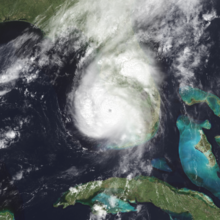This article contains several duplicated citations. The reason given is: DuplicateReferences detected: (November 2024) |
 Charley near peak intensity shortly before landfall in Florida on August 13 | |
| Meteorological history | |
|---|---|
| Formed | August 9, 2004 |
| Extratropical | August 14, 2004 |
| Dissipated | August 15, 2004 |
| Category 4 major hurricane | |
| 1-minute sustained (SSHWS/NWS) | |
| Highest winds | 150 mph (240 km/h) |
| Lowest pressure | 941 mbar (hPa); 27.79 inHg |
| Overall effects | |
| Fatalities | 35 (15 direct, 20 indirect) |
| Damage | $16.9 billion (2004 USD) |
| Areas affected | Jamaica, Cayman Islands, Cuba, East Coast of the United States (especially Florida and the Carolinas) |
| IBTrACS | |
Part of the 2004 Atlantic hurricane season | |
Hurricane Charley was the first of four separate hurricanes to impact or strike Florida during 2004, along with Frances, Ivan and Jeanne, as well as one of the strongest hurricanes ever to strike the United States. It was the third named storm, the second hurricane, and the second major hurricane of the 2004 Atlantic hurricane season. Charley lasted from August 9 to 15, and at its peak intensity it attained 150 mph (240 km/h) winds, making it a strong Category 4 hurricane on the Saffir–Simpson scale. It made landfall in Southwest Florida at maximum strength, making it the strongest hurricane to hit the United States since Hurricane Andrew struck Florida in 1992 and tied with Hurricane Ian as the strongest hurricane to hit southwest Florida in recorded history.
After moving slowly through the Caribbean, Charley crossed Cuba on Friday, August 13 as a Category 3 hurricane, causing heavy damage and four deaths. That same day, it crossed over the Dry Tortugas, just 22 hours after Tropical Storm Bonnie had struck northwestern Florida. It was the first time in history that two tropical cyclones struck the same state in a 24-hour period.[1] At its peak intensity of 150 mph (240 km/h), Hurricane Charley struck the northern tip of Captiva Island and the southern tip of North Captiva Island, before crossing over Bokeelia causing severe damage.[2] Charley then continued to produce severe damage as it made landfall on the peninsula in Punta Gorda. It continued to the north-northeast along the Peace River corridor, devastating Punta Gorda, Port Charlotte, Cleveland, Fort Ogden, Nocatee, Arcadia, Zolfo Springs, Sebring, Lake Placid, and Wauchula. Zolfo Springs was isolated for nearly two days as masses of large trees, power poles, power lines, transformers, and debris filled the streets. Wauchula sustained gusts to 147 mph (237 km/h); buildings in the downtown areas caved onto Main Street.
Ultimately, the storm passed through the central and eastern parts of the Orlando metropolitan area, still carrying winds gusting up to 106 mph (171 km/h). The city of Winter Park, north of Orlando, also sustained considerable damage since its many old, large oak trees had not experienced high winds. Falling trees tore down power utilities and smashed cars, and their huge roots lifted underground water and sewer utilities. The storm slowed as it exited the state over Ormond Beach just north of Daytona Beach. The storm was ultimately absorbed by a front in the Atlantic Ocean shortly after sunrise on August 15, near southeastern Massachusetts.[3][4]
Charley was initially expected to hit further north in Tampa, and caught many Floridians off-guard due to a sudden change in the storm's track as it approached the state. Along its path, Charley caused 10 deaths and $16.9 billion in damage to insured residential property, making it the second costliest hurricane in United States history at the time.[5] Charley was a compact, fast-moving storm, which limited the scope and severity of the damage.
- ^ David Royse (August 12, 2004). "How Rare is Tropical Storm Double Trouble?". Associated Press. Retrieved September 23, 2022.
- ^ Ed Franks (August 13, 2014). "Hurricane Charley: A look back". Pine Island Eagle. Archived from the original on September 13, 2017. Retrieved September 23, 2022.
- ^ Cite error: The named reference
tcrwas invoked but never defined (see the help page). - ^ Cite error: The named reference
hpcwas invoked but never defined (see the help page). - ^ "Rescuers sift debris from Hurricane Charley". The Sydney Morning Herald. Agence France-Presse. August 17, 2004. Retrieved August 27, 2017.